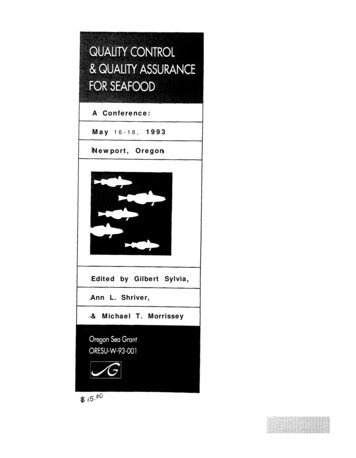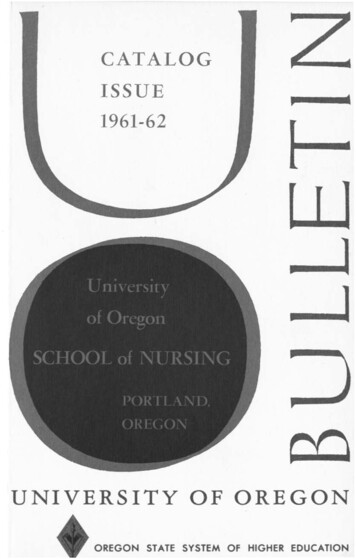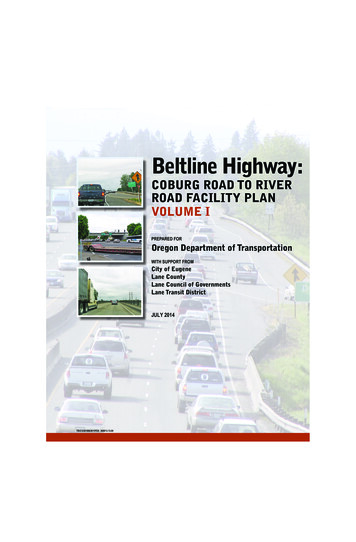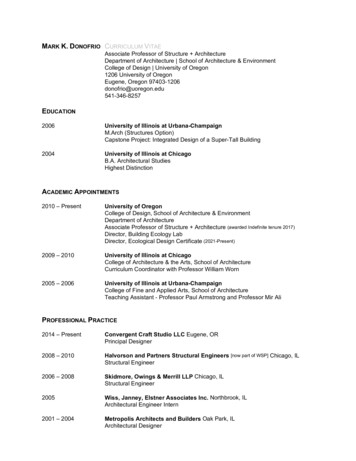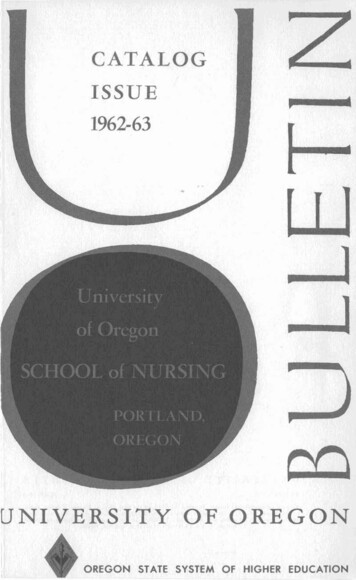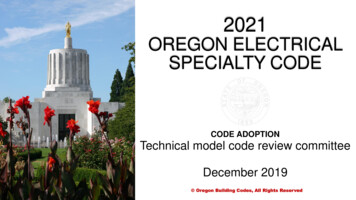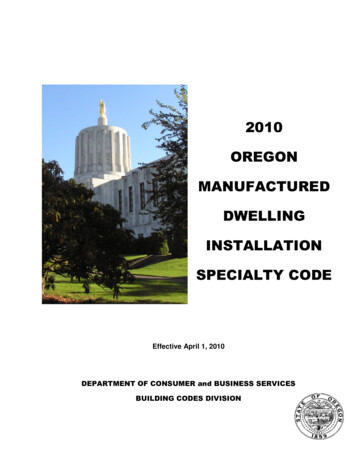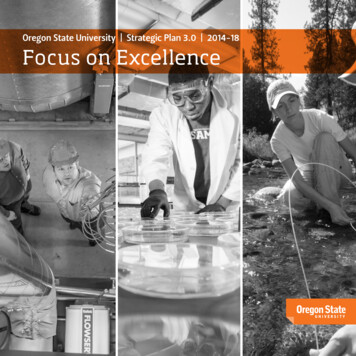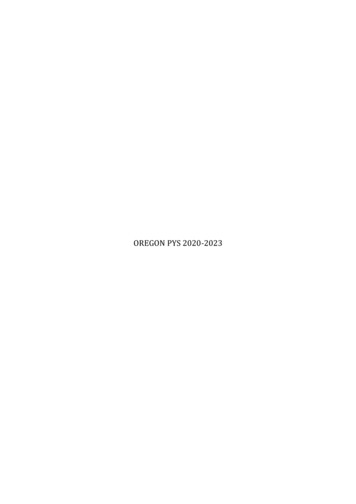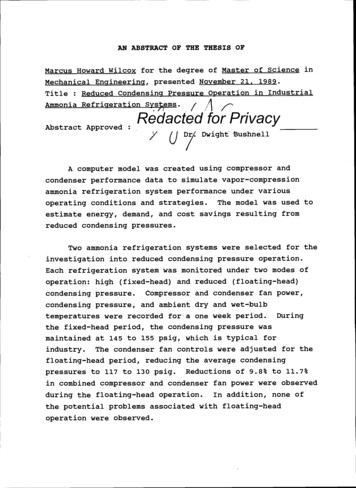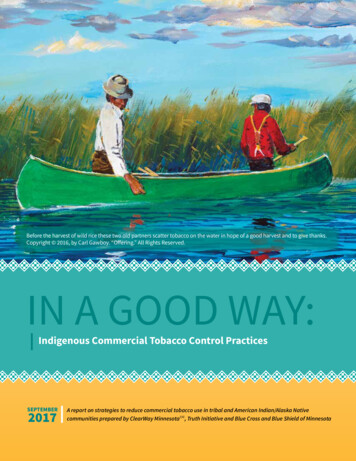
Transcription
Before the harvest of wild rice these two old partners scatter tobacco on the water in hope of a good harvest and to give thanks.Copyright 2016, by Carl Gawboy. “Offering.” All Rights Reserved.IN A GOOD WAY:Indigenous Commercial Tobacco Control PracticesSEPTEMBER2017A report on strategies to reduce commercial tobacco use in tribal and American Indian/Alaska Nativecommunities prepared by ClearWay MinnesotaSM, Truth Initiative and Blue Cross and Blue Shield of Minnesota
ACKNOWLEDGEMENTSClearWay Minnesota, Truth Initiative, Blue Cross and Blue Shield of Minnesota and Laura Hamasaka(consultant) conceptualized the framework, reviewed drafts, and contributed to the writing of this report.Zachary Slobig served as the principal writer.The following ClearWay Minnesota, Truth Initiative, Blue Cross and Blue Shield of Minnesota staff alsoreviewed and contributed to the creation of the document.Jaime Martínez and CoCo Villaluz, ClearWay MinnesotaSM Ines Alex Parks, Truth InitiativeChris Matter, Blue Cross and Blue Shield of MinnesotaWe would like to thank all those who contributed to this report by sharing their wisdom and lived experienceas practitioners in the field, researchers, tireless advocates, and community leaders.Amanda Dionne: American Indian Cancer FoundationJean Anne Moose: Nez Perce TribeEdy Rodewald: Southeast Alaska Regional HealthConsortiumJune Maher: Cherokee NationShanna Hammond: Hannahville Indian CommunityHealth ServicesJulie Stetson: White Earth Nation Public HealthRoberta Marie: Fond du Lac Band of Lake SuperiorChippewa, CloquetChris Matter: Blue Cross and Blue Shield of MinnesotaEarl Villebrun: Bois Forte Band of ChippewaJoshua Hudson: National Native Network, IntertribalCouncil of MichiganTianna Marie Odegard: Upper Sioux CommunityLaToya Ross-Sullivan: Upper Sioux CommunityLaTisha Marshall: Centers for Disease Control andPreventionKevin T. Collins: Centers for Disease Control andPreventionJacqueline R. Avery: Centers for Disease Control andPreventionLori Ann New Breast: Amskapipikuni (Blackfeet) NationPatricia Nez Henderson: Black Hills Center forAmerican Indian HealthSadie In The Woods: Great Plains Tribal Chairmen’sHealth BoardKris Rhodes: American Indian Cancer FoundationCarla Feathers: The Muscogee (Creek) NationAlex Parks: Truth InitiativeFrank Yaska: Tanana Chiefs ConferenceRichard Mousseau: Great Plains Tribal Chairmen’sHealth BoardShannon Laing: Michigan Public Health InstituteDawn Newman: University of MinnesotaCoCo Villaluz: ClearWay MinnesotaSMErin O’Gara: ClearWay MinnesotaSMJaime Martínez: ClearWay MinnesotaSMDavid Willoughby: CEO, ClearWay MinnesotaSMLaura Hamasaka: ConsultantCopyright 2017 by ClearWay MinnesotaSM,Truth Initiative and Blue Cross and Blue Shield of Minnesota.All rights reserved. Portions of this document may be used in other documents and manuscripts, but must be cited.2IN A GOOD WAY: Indigenous Commercial Tobacco Control Practices
EXECUTIVE SUMMARYIn public health, we like to focus on evidenced-based practice, but we need to respect theNative tradition and knowledge of practice-based evidence.— Dr. Donald Warne, MD, MPHNorth Dakota State University, Oglala LakotaThis report intends to highlight tribally-based strategies developed over a 10-year periodthrough the Centers for Disease Control and Prevention’s (CDC’s) formerly funded nationalTribal Support Centers and through ClearWay MinnesotaSM’s Tribal Tobacco Educationand Policy (TTEP) grant initiatives. The CDC’s Tribal Support Centers were charged with advancingcommercial tobacco control in tribal and American Indian/Alaska Native (AI/AN) communities acrossthe country, and the TTEP initiative worked on advancing commercial tobacco-free policies on triballands in Minnesota. Both projects have worked to promote health in Indian Country for at least eightto 10 years, working to reduce the harm of commercial tobacco and restoring traditional tobaccopractices. It is crucial that we acknowledge that tobacco exists in two ways in American Indiancommunities. Commercial tobacco use causes death and disease and is marketed for profit. Traditionaltobacco use honors the Creator and is governed by cultural and ceremonial protocols.This report is by no means intended to be a comprehensive look at the broad workaround commercial tobacco education, advocacy and policy reform across the breadthof AI/AN communities, but we hope that it captures the key lessons and spirit of a time whereincreased resources were available to tackle one of the toughest health issues facing indigenouspopulations in the U.S. It is imperative to not approach the search for and replication of solutionswith a ‘one-size-fits-all’ approach. Each of these communities is different, with varyingtraditions, cultural practices and relationships to traditional tobacco. Mainstream publichealth has largely failed to decrease commercial tobacco use rates in these communities.Solutions that have shown impact largely come from within the communitiesthemselves: not top-down solutions, but those emerging from the grassroots.The raw material for this report came in two forms, the first of which was a two-day meetingat the offices of ClearWay MinnesotaSM in October of 2016. That meeting was followed by aseries of individual interviews with the participants which gave the interviewer the opportunity togather more details on issues and themes that had emerged in the meeting. What follows herewill touch on these themes:The Role of Tobacco Traditions in Indian CountryReframing “Best Practices” From an Indian Point of ViewInterventions That Empower All GenerationsHonoring Relationships, Building Capacity WithPartnerships The Historical Context of Policy in AI/ANcommunities Building In-Roads Within Gaming Establishment Culturally AppropriateMessaging Educating Funders,Stakeholders and Researchers The Power of Tribal SpecificData Reawakening and ReconnectingWith Traditional MedicineIN A GOOD WAY: Indigenous Commercial Tobacco Control Practices3
INTRODUCTIONDemographic Context andHealth DisparitiesAmerican Indians and Alaska Native communities are vastly diverse and geographicallydispersed—with some 567 federally recognized tribes spanning from the Athabascans ofAlaska to the Navajo of the Southwest. In 2013 roughly 5.2 million people, or 2 percent ofthe U.S. population, identified as AI/AN. Several hundred additional tribes in the UnitedStates have sought federal recognition but remain unrecognized. This heterogeneouspopulation deserves public health interventions and policy development that avoid thepitfalls of one-size-fits-all approaches.Public health and policy development in Indian Country must also account for thegeneration-spanning impacts of the historic marginalization of American Indians,a legacy that shapes every aspect of these communities. The U.S. governmentremoved American Indian tribes from their indigenous lands and forced thesecommunities to resettle in new, unfamiliar lands against their will. An ancient indigenousway of life, with rich traditions and enduring culture, faced tremendous attack in theform of government-imposed assimilation. The economically depressed conditionsthese communities continue to suffer are a direct result of systematic injustice anddiscrimination, forced relocation and exploitation.Still, within that 2 percent of the U.S. population, great diversity and resiliency exists, andwhile the public health world often treats AI/AN populations as one large homogenousgroup, approaches designed and implemented at the community and tribal levelhave shown the most success. Culturally specific interventions that account for thesocioeconomic, historical and psychological factors that contribute to high commercialtobacco use rates are critically needed.Tribal communities are not simply a minority or a special interest group, they aresovereign nations recognized by all branches of the federal government. With the powersof this sovereignty comes the great benefit of control over policy and laws that supersedeany state or federal laws. Each nation must adopt or develop similar protections.4IN A GOOD WAY: Indigenous Commercial Tobacco Control Practices
Smoking rates in the U.S. general population have decreased thanks to tobaccocontrol policy implementation, education, cessation therapies and broadmedia strategy. The commercial tobacco use rate across AI/ANcommunities has experienced no such broad and measurableimprovement. American Indians taken as a whole reportthe highest commercial tobacco use rates of anyU.S. subpopulation, nearly double the generalpopulation’s. While the need is critical, anunderfunded Indian Health Service andstate health departments have not beenable to provide significant support forcommercial tobacco programs in Indiancountry. The result is debilitatingcommercial tobacco use rates in thesecommunities; these have seen littlechange in the past decades whilerates in the general populationcontinue on a steady downwardtrend.Data from the NationalHealth Interview Survey(NHIS) support thesetroubling facts. Commercial tobaccoprevalence rates for AI/AN are the highestof any racial/ethnic group in the UnitedStates.1 Still, the NHIS statistics are broadbrush and fail to get at the granular differencesbetween communities. As with the generalpopulation, tremendous regional differencesexist in smoking rates for the AI/AN population.According to a 2009 study, 28 percent of Southwesttribal members were smokers compared to 47 percent smoking rateamong Northern Plains tribal members.2 Meanwhile, the cigarette use rate among theAmerican Indian population in Minnesota is 60 percent.3 Smoking in tribal communitiesalso begins at a young age—typically 14 years. In Minnesota, five of the six leading causesof death among American Indians—heart disease, cancer, diabetes, stroke and lowerrespiratory disease—are related to commercial tobacco use.4CDC. Current Cigarette Smoking Among Adults — United States, 2005–2015, 1999 – 2012. MMWR MorbMort Weekly Rep 2016; 65 (44): 1205-1211.2Nez-Henderson, P. et al., Patterns of Cigarette Smoking Initiation in Two Culturally Distinct American IndianTribes. American Journal of Public Health. 2009; 99(11): 2020-2025.3American Indian Community Tobacco Projects. Tribal Tobacco Use Project Survey, Statewide American IndianCommunity Report. 2013.4Centers for Disease Control and Prevention. Health Effects of Cigarette Smoking. http://www.cdc.gov/tobacco/data statistics/fact sheets/health effects/effects cig smoking/. Accessed June 29, 2017.1IN A GOOD WAY: Indigenous Commercial Tobacco Control Practices5
The Role ofTobacco Traditionsin Indian CountryAny exploration of tobacco’s place in IndianCountry must first account for the central rolethat tobacco plays in the traditions of manyAmerican Indian communities. In fact, thehistory of tobacco is in many ways a history ofAmerican Indians. Tobacco was first cultivatedsome 7,000 years ago in the Andes, from whereit spread north through other indigenouscommunities. For these tribes, tobacco is a giftfrom the creator, a sacred medicine cherishedfor its healing properties and its spiritualsignificance. Some believe that smoke fromsacred tobacco will take a prayer directly upto the creator. Each of these communities haselaborate stories about how this plant cameto them from the creator.There are many names for this sacredtobacco: cansasa, canli, pistax’kaan,kinnekenick, aseema, asemaa.This intimate relationship with the plantdates back thousands of years, long beforeEuropean contact. Ceremonial use of tobaccois varied in these communities. It could beused as an offering to the creator, or to amember of the tribe. It may be smoked ornot, but it is not inhaled. Frequency variesas well, from daily to very sparingly. Aswe’ll see in this report, the act of reclaimingthe sacredness of this plant and clearlydistinguishing its traditional use from itsmodern commercial tobacco use—introducedduring an era of grave historical trauma—canprove critical in reshaping societal normsaround tobacco.6IN A GOOD WAY: Indigenous Commercial Tobacco Control Practices
Prior to colonization, many American Indian communities used manyvarieties such as nicotiana rustica (traditional tobacco), red willow treebark, sage, sweet grass, cedar and other botanicals individually orin combination in sacred or ceremonial practice. This substancewas not used casually or socially. Its use was governed bystrict protocols, and in fact this was a powerful form ofindigenous “tobacco control.” In the last century anda half, Indian communities largely began to replacethis usage with nicotiana tabacum, cultivatedcommercial tobacco. Primarily this shift was aresult of draconian government restrictionson American Indian cultural lifeways andpartially this was a result of ease of accessto cultivated commercial tobacco. It was notuntil 1978 with the Indian Religious FreedomAct were Indian communities free to practicetheir indigenous lifeways openly—and usetraditional tobacco in its sacred setting.The legacy of this dynamicrepression cannot beunderestimated. Because ofthese policies, many generationsof young people have grownup seeing only commercialtobacco in ceremonies. Thisloss of tradition and culturehas created severe healthimpacts, and in recent years,many communities haveset out to educate tribalmembers, young and old,on the traditional use of thisplant in an effort to restoreand revitalize those ancientconnections destroyed bycolonization and a hostilefederal government. Evidenceis emerging that efforts torestore the place of traditionaltobacco will help bring downthe high rates of commercialtobacco use.IN A GOOD WAY: Indigenous Commercial Tobacco Control Practices7
Reframing “Best Practices”From an Indigenous Point of ViewThe term “best practices” while generally useful for spreading effective models, presentsgreat challenges in AI/AN communities. The CDC defines best practices as “a practicesupported by a rigorous process of peer review and evaluation indicating effectiveness inimproving health outcomes, generally demonstrated through systematic reviews.”5 This peerreview process and evaluation is constructed from Eurocentric values that do not include the“Indian way” – which does not necessarilye want to bring together thisequate to university training, publicationand recognition for research activities. Bestinformation that is criticalpractices in Indian Country are a specific setto really moving the workof behaviors and wisdom recognized by eachamong native people. We alsocommunity as being valued, and based onthe teachings of elders. AI/AN communitiesneed it as a part of the CDC’shave varied cultural values that may notbest practice guidelines to makealign with a Western paradigm, but thesesure people understand that there’scommunities are just as interested in craftingand implementing programs that work, basedbeen a lot of work done in theseupon sound principles and values.6 Programscommunities.that work in Indian Country are culturally— David Willoughby, relevant, culturally appropriate and designedCEO ClearWay MinnesotaSM in keeping with the “Indian Way.”WKochtitzky, C. Applying a General Best Practice Identification Framework to Environmental Health.Journal of Environmental Health. 2014; 77(4): 40-43.6Cruz, C. Tribal Best Practices: There are Many Pathways. Oregon Department of Human Services.Located at: . Accessed June 29, 2017.58IN A GOOD WAY: Indigenous Commercial Tobacco Control Practices
Public healthpractitioners inIndian Countrycan struggle todemonstrateeffectivenessof programsimplemented intheir communitiesbecause of thismonolithicapproach to thedefinition of bestpractices. Thisreport is an effort to collect and share best practices based on evidence from thoseworking on the frontlines of commercial tobacco control within AI/AN communities, andto educate the mainstream public health community. In October 2016, representativesof 8 Tribal Support Centers and TTEP grantees gathered at the offices of ClearWayMinnesotaSM for two days of reflection and sharing from the frontlines of the commercialtobacco control movement in Indian Country.The Tribal Support Centers and TTEP programs implemented programs and policies,training and technical assistance, and related evaluation. Some Tribal Support Centersand TTEP were grantees for five years and others for 10 years. Over that time, theseprojects accumulated numerous lessons that should be captured and shared as othertribes and organizations implement projects to reduce commercial tobacco use. NewCDC tribal grantees and other tribes can benefit, as can governmental and privatefunders who will continue to be involved in efforts to advance commercial tobaccocontrol in tribal communities across the country.What follows is acollection of snapshotaccounts of thoseefforts shown toeffectively shift normsaround, mitigatethe harms of, andcurtail the use rates ofcommercial tobaccoin these communities.This publicationreflects the grassroots-levelexperiences of a diverse array of AI/ANcommunity advocates and is intended to actas a resource for any organization with aims to lowerthe commercial tobacco use rates and preserve traditionaltobacco teachings in Indian Country.IN A GOOD WAY: Indigenous Commercial Tobacco Control Practices9
SPOTLIGHT:Traditional Healing:Crucial Interventionfor Young People at RiskDuring Sadie In The Woods’s two years as a Project Managerwith the Great Plains Tribal Chairman’s Health Board, themost effective program that she saw shifting norms aroundcommercial tobacco use happened in small groups in thewoods far outside of town.Three years ago a medicine man and his wife, a pair of traditionalhealers, started a Lakota camp for suicidal young people in acommunity with a suicide rate that’s five times the national average. In this community,children as young as 11 years old have taken their lives.The camp’s approach is revolutionary in its simplicity: It revives the nearly lost practicesthat once honored young people at their critical time of coming of age, galvanizing theiridentity and situating them as valued members of a community. The camp began as asmall and passionate initiative of just this couple and has since become a lifeline for themost at-risk young people, and a rallying point for the entire tribe.The camp is a several day sojourn in undeveloped land long held sacred. Here, thesesuicidal youth emerge transformed. Upon arrival, the boys are separated from the girlsand their clothes are torched. “It’s a symbolic burning of the past to release the spirit,”said Sadie In The Woods.The healers erect a sweat lodge and smudge everything with burning sage torelease the negative energies around the young people. Next, they show the kidshow to pray, and guide them along, teaching them the ancient songs. A cleansingfollows, and each one receives a Lakota name of honor. They’re given an eagle featherand learn that they must treat it with utmost respect, keeping it away from drugs andalcohol.“These kids have never been exposed to any of this,” said Sadie In The Woods. “Fewadults in the community have even been exposed to it. These kids have never beenhonored like that.”10IN A GOOD WAY: Indigenous Commercial Tobacco Control Practices
The healers ask but one thing of these young people: They must return to mentor otherkids, to pass along that gift of transformation, that incomparable rootedness whichresults from such an experience. Slowly, that tide of suicide has begun to ebb.The struggles continue for these young people though. Sadie recalls one boy inparticular who came into her offices looking for donations. He said he was raisingmoney to pay for a ticket to a youth summit in Washington, D.C. “He was homeless,” sheremembered. “He told us he wished that non-Native people would stop treating him likea criminal. He brought me to tears.”He went off to the Lakota camp and walked in the footsteps of his ancestors.There he learned about traditional sacred tobacco, how to cultivate it, when toplant it and where. “If the roots are twisted, for instance, you can’t plant it,” saidSadie in the Woods. “He learned what songs to sing, and how to harvest it. He learnedthe power of prayer and the place of sacred tobacco.”Sadie’s staff awarded him a mini-grant through the Tribal Support Center resources, andhe proudly represented his community at that Youth Summit in Washington, DC. It wasa place this young man never thought he’d find himself. Now 17 years old, he mentorsother young people at the Lakota camp, kidsstruggling to find their way in a world thatseems stacked against them.He teaches them about the vicious destructioncaused by commercial tobacco, and the properplace of traditional tobacco as a healingforce. “He continues to do this even withoutfunding,” said Sadie In The Woods. “Thatyoung man is going to be a leader.”These are the kids who become powerfuladvocates for progressive tobacco policy,she says. These are the ones that show up tocouncil meetings when resolutions are up for avote. It’s most powerful when elders join theseyoung people as advocates.These kids have never beenexposed to any of this. Fewadults in the community haveeven been exposed to it.These kids have never beenhonored like that.— Sadie In The Woods,Great Plains Tribal Chairman’s Health Board“That’s the combination that really works,” she said, remembering one meeting wherea 96-year-old nurse, long-time commercial tobacco control advocate in the tribalcommunity and a celebrated elder, joined them silently and looked on with quiet pride.“It’s so nice to just sit here and rest,” she told Sadie In The Woods. “So nice to watch theyoung people do the hard work.”IN A GOOD WAY: Indigenous Commercial Tobacco Control Practices11
Empowering All GenerationsMany of the Tribal Support Centers report marked success with approaches thatintentionally bring both youth and elders to the table. These intergenerationalapproaches value the wisdom found at both ends of the age spectrum andhonor the experiences of each member of the community. June Maher, manager of theTobacco Prevention Program at the Cherokee Nation in Oklahoma points to the richyouth engagement in her community that turned the tide towards smoke-free policies.Cherokee Nation encompasses 14 counties with distinct jurisdictions and Maher believesthat the local SWAT Teams (Students Working Against Tobacco) were the real driver ofchange.“Those teams were able to go in to the City Council and get ordinances passed,” saidMaher. “If I went up there, they would not have listened to me. They listen to the youth.”Those efforts resulted in the Cherokee Nation passing one of the most comprehensivetobacco policies in Indian Country. Sadie In The Woods, Manager of the TobaccoPrevention Program for the Great Plains Tribal Chairman’s Health Board, also points tothe impact of youth engagement on policy change, particularly the work of Teens AgainstTobacco Use (TATU) groups. Change can come slowly in traditional communities, andsome of the most persuasive agents of change are often the young people.Sadie In The Woods described a particularly unique intervention aimed at the mostat-risk segment of the youth population in her community. Young people whosuffered from severe depression and havecontemplated or attempted suicide arethink we’re really starting to engage invited to attend a traditional Lakota healingcamp where they participate in ceremoniesour youth more and realize thatand are given new Lakota names. They areour youth have teachings that wealso taught the cultivation and preparationcan learn from them and notof traditional tobacco as well as how to useit in sacred rituals. Replacing commercialthe other way around all thetobacco practices with culturally appropriatetime.”traditional tobacco use, she believes— Josh Hudson, considerably lowers the stress and anxietyIntertribal Council of Michigan, these young people endure from a bitterNational Native Network legacy of historical trauma.ISome of these young people emerge fromthe camp as energized leaders and ambassadors of the appropriate use of traditionaltobacco. “I thought that was one of the most unique things that I participated in thatpossibly saved some of those kids,” she said. “I think when we listen to our tribes and wetry really hard to partner wherever we can, it turns out to be really beautiful.”12IN A GOOD WAY: Indigenous Commercial Tobacco Control Practices
Edy Rodewald with the Southeast Alaskan Health Consortium sees that the tribalcommunities where she works all place great value on protecting the youth, creating anatural overlap between the elders and young people. “One traditional value in mostof the cultures is promoting the idea that the youth are the future,” she said. “So evenpeople who are addicted to tobacco and aren’t able to quit, they don’t want the youngpeople to start, so they’re willing to pass policies that may make it less convenient foryouth to start. They do it for the children, forfuture generations. When you work with thevalues that way, it’s more of a positive way tohey’re all saying our youngapproach the elders.”Tpeople are at risk. Well, I preferto think of them as promisingwarriors, and like anywarrior, you have those pointswhere you overcome.Health and wellness coalitions that includeboth young people and elders, working sideby side, appear to be particularly effective.“When I look at these communities thathave great success, it’s because of theircoalitions,” said Richard Mousseau, Director— Lori New Breast,of Prevention Programs at Great Plains TribalBlackfeet NationChairmen’s Health Board. “Take for instanceCheyenne River, they had a coalition of eldersand younger individuals, in general goodcommunity leaders, even though they might not be tribal council people, or chairpeople, or even CEOs. They can still have a big impact on tribal council if consistentlypressing the issue. They were really instrumental in the tribal community going smokefre e .”Shanna Hammond, Health Educator at the Hannahville Health Center in Michigan,facilitates a Health Advisory Council comprised of volunteers ranging fromyoung people in their 20s to elders. This group of health championsinfluenced policy and were trained to conduct theAmerican Indian Adult Tobacco Survey (AIATS). They collected crucial tobacco usedata through a process of face-to-facesurveying. These types of crossgenerational engagements appearto be particularly helpful in tribalcommunities. To authenticallyengage young people in leadershipand advocacy is just as important ashonoring the wisdom of elders whomay hold more sway in shaping policy.IN A GOOD WAY: Indigenous Commercial Tobacco Control Practices13
SPOTLIGHT:Preparing for the 7thGeneration: Tribal and StateCollaboration in OklahomaJune Maher has worked on thefrontlines of commercial tobaccocontrol in Cherokee Nation formore than three decades, and hascollected a wealth of experiencealong the way. She’s also collectedallies and partners—like Sally Carterin the Oklahoma State Departmentof Health—who have collaboratedwith tribes towards incrementalsystems change, from educationand advocacy, to coalition buildingand policy change.Maher began her publichealth career with atobacco educationcurriculum for elementary schoolstudents, exposing them to thedeceptive practices that commercialtobacco companies use to lure kidsinto the a deadly habit, and theninto addiction. “We’d show them theVirginia Slims ads with the slenderladies and the white teeth,” recalledMaher. “We tell them all about howthey target kids, even third andfourth graders.”Carter, a licensed social worker, looks at the impact of commercial tobacco use intribal populations as a social justice issue. “We’d see these prevalence reports with thenumbers for the tribal populations so much higher, and I think, ‘well that just doesn’tseem right. What can I do?’” Carter said. She realized early on that sustainable, durable,systems-level change on this issue required working relationships between the tribesand the state—something that had not ever existed to a degree that resulted in realpositive change.14IN A GOOD WAY: Indigenous Commercial Tobacco Control Practices
“It takes someone like Sallyto walk in with a softvoice and ask, ‘How canwe help you all?’” said Maher.That had never happened. Thetribes wanted a directory thatlisted all the cessation resourcesfor each tribe so health workerscould have them organized forreferrals. This initial engagementwas actually something that thestate considered so low-impactthat it wouldn’t normally deserveresources.“As a social worker, you meet people where they are,” said Carter. “That’s what theyneeded, to have something to hand out to everybody at their clinic, the doctors andnurses. That allowed us to begin to establish relationships.”From this low-impact engagement, a working group formed that met monthly withCarter under a collaborative governance model where no single party had more influencethan another. Every month, Carter made the 12-hour drive to meet with this group ofelders. “Tribal partners had equal decision making and they were at the table every stepof the way,” said Carter. “You can’t get to the bottom of stuff unless you sit across thetable and get real with each other.”At these monthly meetings, Carter learned about all the problems the tribes havehistorically had with the state. She learned about the depth of distrust based on a longhistory of oppression. She learned that thestate had never been a reliable partner. Sheribal partners had equalfound out that there was language in thedecision making and theyboilerplate contract that threatened tribalwere at the table every stepsovereignty.Tof the way. You can’t get to thebottom of stuff unless you sitacross the table and get real witheac
Joshua Hudson: National Native Network, Intertribal Council of Michigan Tianna Marie Odegard: Upper Sioux Community LaToya Ross-Sullivan: Upper Sioux Community LaTisha Marshall: Centers for Disease Control and Prevention Kevin T. Collins: Centers for Disease Control and Prevention Jacqueline R. Avery: Centers for Disease Control and Prevention
